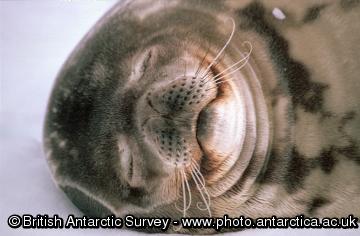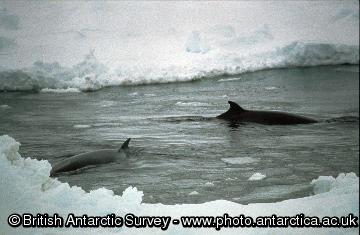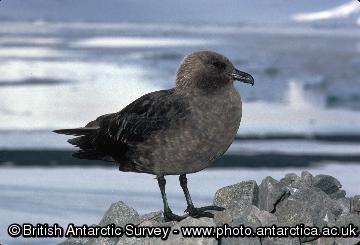Position: Lat. 75°35′S, Long. 26°34′W
(Known as Halley Bay until 15 Aug 1977)
Purpose: Scientific activities Primarily atmospheric sciences, but also survey, geology and glaciology.
Occupied: 15 Jan 1956 to the present.
Station facilities
Halley V contains a mix of building technologies. Three buildings are located on platforms on steel legs, which have been jacked up annually to keep them clear of the accumulated snowfall. An accommodation building and a garage weighing over 50 tons are mounted on skis and towed each year to a new position. Halley I to Halley IV were built directly on the snow and were each abandoned within ten years, having been crushed by the overlying ice.
The station operates throughout the year with a maximum population of 70 in the summer and an average of 16 over winter. The Emperor penguin colony near Halley, which is present from May to February, is a special attraction, while other recreational trips take members further inland towards the “hinge zone” where the floating ice shelf is joined to the continent.
Approximately 1.2 metres of snow accumulate each year on the Brunt Ice Shelf and buildings on the surface become covered and eventually crushed by snow, necessitating periodic rebuilding of the station. This part of the ice shelf is also moving westward by approx. 700m per year.
There have been five Halley bases built so far. The first four were all buried by snow accumulation and crushed until they were uninhabitable. Various construction methods were tried, from unprotected wooden huts to steel tunnels. Halley V has the main buildings built on steel platforms that are raised annually to keep them above the snow surface.
A design competition was launched by the Royal Institute of British Architects and the British Antarctic Survey in June 2004 to provide a new design for Halley VI. The competition was entered by a number of architectural and engineering firms. In July 2005 the winning design was chosen, by Faber Maunsell and Hugh Broughton Architects. It is a structure which is, like Halley V, jacked up on legs to keep it above the accumulation of snow. But unlike Halley V, there are skis on the bottom of these legs, which allows the building to be relocated periodically.
Station Personnel
During winter there are usually around 16 over wintering staff (winterers). In the summer period, from late December to early March, these staffs increase to around 70.
It is often not clear from articles about Antarctic bases that very few of the winterers are scientists. Most are the technical specialists required to keep the station and the scientific experiments running. The wintering team at Halley includes a chef, a doctor, mechanics, an electrician, several electronics engineers and a heating and ventilation engineer.
One of the winterers each year is designated as the Winter Base Commander and sworn in as a magistrate; this job is carried out in addition to their normal duties.
1996 saw the first female winterers at Halley, reflecting the changes within the British Antarctic Survey. There have been at least two women wintering every year since then.
Life on Station
The major event of each year is the arrival of the ship (currently the RRS Ernest Shackleton, before 1999 the RRS Bransfield) in late December. As soon as the ship arrives the work of relief begins, unloading all the cargo and the reloading of all waste This usually takes about a week of 24-hour working, with a fleet of Sno-Cats hauling sledges of cargo the fifteen or so kilometres from the coast. Depending on sea ice conditions and the topology of the ice coast this might involve a drive of sixty kilometres from (N9), or as in one recent year when the ship was unable to reach the base, ferrying of important cargo and personnel by plane from further up the coast.
New vehicles arrived at Halley during the 2006-2007 season, Challenger 765B and John Deere 7820T, a significant increase of delivery of goods to Halley was observed. Both the John Deere and Challenger units can deliver significant quantities of sledges to Halley in one go and decreased the time of relief significantly.
After this life continues to be hectic as there is a lot of work to be carried out during the short summer period. This includes both scientific activities and the major maintenance for the current Halley V station. As of 2007-2008 season will see the start of the construction of the new Halley research station Halley VI.
Because of the rebuild the ship (RRS Ernest Shackleton) will arrive mid December along with a larger cargo ship with materials for the new Halley station. There will also be an increase in numbers of personnel as well as a slightly longer season than normal.
Around the end of February the ship makes its final visit to Halley. Summer staff, departing winterers and outgoing cargo are loaded on board and the remaining winterers watch their last physical link with the outside world sail off into the distance.
The next event in the base calendar is sundown, the last day when the sun rises over the horizon this is usually marked with a celebration. The oldest winterer lowers the tattered remains of the Union Flag.
Midwinter has been celebrated in Antarctica since the days of the early explorers and at Halley there is a week of events and parties culminating in the huge midwinter meal. The BBC World Service transmits a special programme with messages from home and a piece of music chosen by each base. It is traditional for the winterers to streak around the building, although they are allowed to wear hats, gloves and boots.
Sunup marks the return of the sun with a barbecue (weather permitting); the youngest winterer raises a new flag.
Climate
Temperatures at Halley rarely rise above 0°C although temperatures around -10°C are common on sunny summer days. Typical winter 
Winds are predominantly from the east; strong winds usually pick up the dusty surface snow reducing visibility to a few metres.
One of the reasons for the location of Halley is that it is under the auroral oval, resulting in frequent displays of the Aurora Australis overhead. These are easiest to see during the 105 days when the sun does not rise above the horizon.
Science
It was here in 1985 that British scientists first measured the ozone depletion of the Antarctic stratosphere. Their discovery that this critical protection from ultraviolet radiation had been decreasing from 1975-1985 made headlines around the world and spurred the international agreement on banning chlorofluorocarbons (CFCs).
Measurements are taken of the ice of Antarctica beneath, of the air in the troposphere above, of the ozone in the stratosphere above that, and of the plasma in the geospace beyond them all.
The scientific programs done at the Halley base include atmospheric sciences, geology and glaciology. Studies at Halley are crucial for a global perspective on ozone reduction, atmospheric pollution, sea level rise, and climate change. Halley, lying within the auroral zone, is ideally situated for geospace research.
History
Halley was founded in 1956, for the International Geophysical Year of 1957-58, by an expedition from the Royal Society. The bay where the expedition decided to set up their base was named Halley Bay, after the astronomer Edmond Halley. The name was changed to Halley in 1977 as the original bay had disappeared due to changes in the ice shelf.
Wildlife
Penguins

The Emperor penguin lays its single egg during the coldest time of the year, when temperatures drop to as low as -80° F and winds reach velocities of up to 112 miles per hour.
Emperors have by far the deepest and longest dives for any bird. They often reach depths of 700 feet, and can stay submerged for up to 18minutes.
Emperors are insulated in part by a dense network of feathers – about 70 feathers per square inch.
Seals
These seals were named for the British Antarctic explorer James Weddell, who commanded British expeditions into the Weddell Sea (which is also named for him).
Weddell seals live farther south than any other mammal.
Weddell seals use their large, strong, forward-pointing canine teeth to chew breathing holes through cracks in the ice.
Weddell seals have excellent eyesight allowing them to navigate effectively in the dim light beneath Antarctic ice shelves.
Weddell seals can dive over 2000 feet deep and stay submerged for over an hour.

The Leopard seal is the largest of the true Antarctic seals.
Leopard Seals are the only seals that eat other seals.
Leopard seals have excellent senses of sight and smell under water.
Leopard seals catch penguins by their feet and then beat them back and forth on the surface of the water to skin them. Then, they eat the carcass.
Whales
The Minke was named for an infamous 18th-century Norwegian whaler who regularly broke the rules concerning the types and sizes of whales that he was permitted at that time to hunt. Soon all the small whales became known as ‘Minke’s whales’.
Minkes are the only baleen whale that is still-hunted commercially. Japanese and Norwegian whalers kill a few hundred each year for scientific purposes and for meat.
The Minke whale has a remarkable song that sounds very mechanical, causing some problems for military sonar listening for submarines during WWII.
Like other toothed whales, Orcas (Killer Whale) use ‘echolocation’ to navigate and find prey; they emit high-pitched clicks and sense them as they bounce back off objects.
The largest population of Orca whales seems to be in Antarctica where it is estimated some 160,000 animals range.
Orcas don’t make long, seasonal migrations, though they may cover an area of hundreds of miles in order to find seasonal prey.
Orcas can swim up to 30 miles per hour in short bursts.
Female Orcas have a sickle-shaped dorsal fin, but in the male it is triangular and reaches almost six feet in height.
Orca pods have their own ‘dialect’ of discrete calls, which aid in navigation, detecting prey, or sensing danger.
Typical of most whales, Orca calves are born tail first.
Orcas have a lifespan in excess of 50 years.
Birds

Snow Petrels tend to fly low over the water but very high over land to avoid predators such as South Polar skuas. Their flight is more fluttering than most petrels.
Unlike most of the petrel family, Snow Petrels are nervous at the nest and will desert their eggs if overly disturbed.
Old-time whalers used to call Giant Petrels ‘breakbones’ because of their frequent blood-stained brawls over carrion meat.
Diving petrels are small seabirds with stubby wings that seem to whir like wind-up toys as they buzz about the sky in perpetual motion.
Where most petrels flap and glide, diving petrels actually ‘fly’ under water quite similar to penguins.
Storm petrels are the smallest and lightest seabirds in the world.
The Wilson’s Storm petrel skips across the surface of the water as it feeds, stirring up small marine organisms with its feet.
Wilson’s Storm petrels feed while on the wing, skimming and pattering with their feet over the sea surface.
White-chinned petrels have been called ‘cape hens’ and also ‘shoemakers,’ the latter based on their call, which resembles that of a cobbler hammering shoes.
The South Polar skua is recognized as the world’s most southerly bird: sightings have occurred even at the South Pole.
Sea, South Polars may chase smaller seabirds to force them to regurgitate or drop their prey; this is called ‘kleptoparasitism.’
Some scientists believe decreases in skua populations on some islands may be due to declines in burrowing petrel numbers (a key prey species) from predation by introduced cats.
Skuas like to bathe in freshwater pools.






